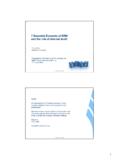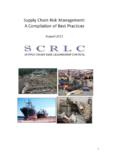Transcription of Risk Management Update - inconsult.com.au
1 Risk Management Update ISO 31000 Overview and Implications for Managers Contents - ISO 31000 highlights 1 - Changes to key terms and definitions 2 - Aligning key components of the risk Management framework 3 - The risk Management process 4 - The principles of risk Management 5 - Strategies for enhancing risk Management 7 - ISO 31000 transition implications and tips for managers 8 - More information 9 IMPORTANT NOTE: Reproduced with permission from SAI Global under License 0912-C079. This Update is not intended to replace ISO 31000 . It aims to highlight some of the important changes from AS/NZS 4360 and provide some insight and valuable tips to help organisations who want to implement an effective risk Management framework. Risk Management Update ISO 31000 Overview and Implications for Managers InConsult 2009 Page 1 ISO 31000 highlights Background In November 2009, the International Organization for Standardization (ISO) finally released the very much anticipated and first international risk Management standard titled ISO 31000 :2009 Risk Management Principles and Guidelines (ISO 31000 ) to provide organisations with principles and generic guidelines on risk Management .
2 ISO 31000 has been developed using experts from around the world, from various industries and disciplines. The Standard aims to provide organisations with guidance and a common platform for managing different types of risks , from many sources irrespective of the organisations size, type, complexity, structure, activities or location. In Australia, ISO 31000 has been adopted by Standards Australia and will be officially known as AS/NZS ISO 31000 :2009 Risk Management - Principles and Guidelines. In this briefing, we will refer to it simply as ISO 31000 . The new Standard will replace the popular and highly respected AS/NZS 4360:2004 Risk Management standard. AS/NZS 4360 was originally developed by Australia and New Zealand in 1995 and has served risk managers from around the world well ever since. In fact, ISO 31000 is largely based on AS/NZS 4360 and one could argue that a revised 2009 version of AS/NZS 4360 would virtually look the same as ISO 31000 .
3 Key differences Whilst the fundamentals of the risk Management process in ISO 31000 remain the same as in AS/NZS 4360, there are a number of important changes organisations must consider when adopting ISO 31000 : ISO 31000 is a true international risk Management standard and stands along side other well recognised international standards like the ISO 9000 series of Quality Management standards. The international flavour will be critical for the many global organisations wanting a consistent risk Management There are changes to important terms and definitions, some new definitions are introduced and some definitions are removed. The relationship between the principles for managing risk, the framework for managing risk and the risk Management process are better explained and illustrated in ISO 31000 . There are eleven principles introduced in ISO 31000 that need to be considered to help make risk Management effective. ISO 31000 now lists and describes five attributes of an enhanced risk Management framework.
4 Implications for organisations Organisations with a relatively mature risk Management framework and already utilising AS/NZS 4360 will need to make only minor, mainly cosmetic changes. We recommend risk managers undertake a review of their current risk Management framework and benchmark it against ISO 31000 . Organisations with less developed frameworks that are considering implementing a more proactive, structured risk Management approach will find the standard valuable in helping shape the development of their risk Management framework. Whilst ISO 31000 has a few gaps, it marks a significant milestone towards harmonising risk Management practices globally and the ISO Working Group which developed the Standard should be commended. Risk Management Update ISO 31000 Overview and Implications for Managers InConsult 2009 Page 2 Changes to key terms and definitions One of the primary objectives of ISO 31000 is to achieve a level of consistency in risk Management practice without the rigid uniformity.
5 In order to help achieve this objective, ISO 31000 has redefined some key terms, deleted some terms and introduced new terms. Whilst many of the definitions are similar to AS/NZS 4360, the amendments to the various terms are an excellent enhancement and reflect the maturity of the new Standard. Refined definitions When you bring together experts from many disciplines, cultures and countries, it is not surprising that ISO 31000 has redefined some important and widely used terms. Risk is now defined as the effect of uncertainty on objectives . The emphasis is now on the effect rather than the chance . Like AS/NZS 4360, the definition is neutral in terms of negative and positive consequences of uncertainties and there is still a focus on objectives. The definition of risk Management has changed to coordinated activities to direct and control an organization with regard to risk , rather than listing various components ( culture, processes, structures) as AS/NZS 4360 did.
6 Deleted definitions Some of the more basic terms contained in AS/NZS 4360 have been removed. The terms Hazard, Loss, Frequency, Probability, Control Assessment, Risk Avoidance, Risk Reduction, Risk Retention and Risk Sharing were specifically defined in AS/NZS 4360 but they are not specifically defined in ISO 31000 . New definitions ISO 31000 has introduced some important and more pertinent terms. Risk owner is defined as a person or entity with the accountability and authority to manage a risk. This definition will help the risk manager reinforce to Management that risk ownership must be with Management and not with the risk manager. Risk appetite is an area that many organisations struggle with and whilst risk appetite, is not defined in ISO 31000 (it is in ISO Guide 73:2009), the Standard defines risk attitude as the organisation's approach to assess and eventually pursue, retain, take or turn away from risk.
7 Risk Management policy is also defined as a statement of the overall intentions and direction of an organization related to risk Management . The risk Management plan should specify the approach, the Management components and resources to be applied to the Management of risk. ISO has released ISO Guide 73:2009 Risk Management - Vocabulary to provide further guidance with respect to generic terms and definitions relating to risk Management to support consistency. It contains some of the definitions now deleted from ISO 31000 . Risk Management Update ISO 31000 Overview and Implications for Managers InConsult 2009 Page 3 Aligning key components of the risk Management framework An effective, structured, proactive and enterprise-wide risk Management framework doesn t just happen, the right foundations must be established and the many components must be aligned. The relationships between the various components of managing risks including the risk Management framework is better highlighted and illustrated in ISO 31000 as shown in figure 1 below.
8 Mandate and commitment: Risk Management is not a one-off project; it is an ongoing activity requiring ongoing commitment. It must be mandated from the Board (or equivalent), implemented by senior Management and supported by all levels of Management and risk owners to be sustainable. Design of framework for managing risk: Like all good projects, processes and strategies, risk Management processes must be well designed to support effective implementation. Defining the context of risk Management framework, formulating a risk Management policy, embedding processes into practice, assigning resources and determining responsibility are all key elements of designing an effective framework to manage risk. Well designed periodic reporting to stakeholders and effective communication mechanisms will support effective implementation. Implementing risk Management : Once the framework has been designed, implementation is about putting the theory into practice and actually bringing the risk Management framework to life.
9 Specifically, this is about ensuring the risk Management process is understood by risk owners (through good communication and training), and risk Management activities actually take place (through risk assessments, risk workshops, internal controls etc) and decisions and business processes actually factor in risk thinking. Monitoring and review: Involves confirmation that the various risk Management elements and activities are actually working effectively in line with expectations. Any gaps identified will need to be documented and remediated. Continual improvement: This is about continuing to tweak and enhance key elements of the risk Management framework to either improve current processes and/or progress towards a more mature risk Management framework. A highly committed organisation will improve both its processes and mature over time. Figure 1: The relationship between various components of the risk Management framework Mandate and commitmentDesign of framework to manage riskImplementing risk managementMonitoring and reviewing frameworkContinual improvementRisk Management Update ISO 31000 Overview and Implications for Managers InConsult 2009 Page 4 Figure 2: The risk Management process The risk Management process The risk Management process in ISO 31000 is identical to AS/NZS 4360.
10 As illustrated in figure 2 below, it comprises of five key activities. Communication and consultation: This is concerned with engaging internal and external stakeholders throughout the risk Management process. The Standard promotes a consultative team approach . From the out set, good communication with key stakeholders will help establish expectations, shape the context of risk Management and ensure their needs are considered very important for buy in. Throughout the risk Management process, various written and verbal communications between the risk manager, risk owner and stakeholders will continue to occur. Establishing context: Establishing context is about setting the parameters or boundaries around the organisations risk appetite and risk Management activities. It requires consideration of the external factors such as social, cultural, political and economic and the alignment with internal factors such as strategy, resources and capabilities.




